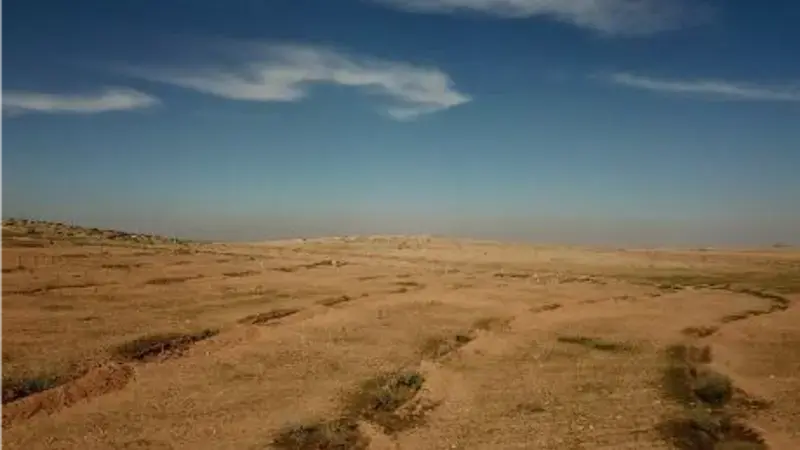Vallerani micro water harvesting

The IPCC Special Report on climate change, desertification, land degradation, sustainable land management, food security, and greenhouse gas fluxes in terrestrial ecosystems, refers to ICARDA's work inIntegrated Watershed Management in Jordan (August 2019).
Population growth, migration into Jordan and changes in climate have resulted in desertification of the Jordan Badia region. The Badia region covers more than 80% of the country’s area and receives less than 200 mm of rainfall per year, with some areas receiving less than 100 mm. Climate analysis has indicated a generally increasing dryness over the West Asia and Middle Eastern region with reduction in average annual rainfall in Jordan’s Badia area.
The incidence of extreme rainfall events has not declined over the region. Locally increased incidence of extreme events over the Mediterranean region have been proposed. The practice of intensive and localised livestock herding, in combination with deep ploughing and unproductive barley agriculture, are the main drivers of severe land degradation and depletion of the rangeland natural resources. This affected both the quantity and the diversity of vegetation as native plants with a high nutrition value were replaced with invasive species with low palatability and nutritional content.
The sparsely covered and crusted soils in Jordan’s Badia area have a low rainfall interception and infiltration rate, which leads to increased surface runoff and subsequent erosion and gullying, speeding up the drainage of rainwater from the watersheds that can result in downstream flooding in Amman, Jordan.
Mechanized Micro Rainwater Harvesting (MIRWH) technology using the ‘Vallerani plough’
To restore the desertified Badia an IWM plan was developed using hillslope implemented water harvesting micro catchments as a targeted restoration approach. Mechanized Micro Rainwater Harvesting (MIRWH) technology using the ‘Vallerani plough’ is being widely applied for rehabilitation of highly degraded rangeland areas in Jordan. Tractor digs out small water harvesting pits on the contour of the slope allowing the retention, infiltration and the local storage of surface runoff in the soil. The micro catchments are planted with native shrub seedlings, such as saltbush (Atriplex halimus), with enhanced survival as a function of increased soil moisture and increased dry matter yields (>300 kg ha-126 ) that can serve as forage for livestock.
Simultaneously to MIRWH upland measures, the gully erosion is being treated through intermittent stone plug intervention (Figure 3.19), stabilising the gully beds, increasing soil moisture in proximity of the plugs and dissipating the surface runoff’s energy, and mitigating further back-cutting erosion and quick drainage of water. Eventually, the treated gully areas silt up and dense vegetation cover can re-establish. In addition, grazing management practices are implemented to increase the longevity of the treatment. Ultimately, the recruitment processes and revegetation shall control the watershed’s hydrological regime through rainfall interception, surface runoff deceleration and filtration, combined with the less erodible and enhanced infiltration characteristics of the rehabilitated soils. In-depth understanding of the Badia’s rangeland status transition, coupled with sustainable rangeland management, are still subject to further investigation, development and adoption; required to mitigate the ongoing degradation of the Middle Eastern rangeland ecosystems.
Dr. Theib Oweis of ICARDA indicated that costs of the fully automated Vallerani technique was approximately USD 32 ha-116 . The total cost of the restoration package included the production, planting, and maintenance of the shrub seedlings (USD 11 ha-117 ). Other experts calculated a benefit cost ratio (BCR) of >1.5 for revegetation of degraded Badia areas through MIRWH and saltbush. However, costs vary based on the seedling’s costs and availability of trained labour.
Water harvesting is not a recent scientific advancement. Water harvesting has been
documented having evolved during the Bronze Age and was widely practiced in the Negev Desert during the Byzantine time period (1300-1600 years ago). Through construction of various structures made for packed clay and stone, water was either held on site in half-circular dam structures (Hafir) that faced up slope to capture runoff or on terraces that slowed water allowing it to infiltrate and to be stored in the soil profile. Numerous other systems were designed to capture water in below ground cisterns to be used later to provide water to livestock or for domestic use. Other water harvesting techniques divert runoff from hillslopes or wadis and spread the water in a systematic manner across playas and the toe slope of a hillslope.
These systems allow production of crops in areas with 100 mm of average annual precipitation by harvesting an additional 300+ mm of water. Water harvesting provides a proven technology to mitigate or adapt to climate change where precipitation maybe reduced and allow for small scale crop and livestock production to continue supporting local needs.
Reference:
The IPCC Special Report on climate change, desertification, land degradation, sustainable land management, food security, and greenhouse gas fluxes in terrestrial ecosystems. pages 3-78 to 3-80
For further information: contact Stefan Strohmeier, Associate Scientist - Soil and Water Conservation (ICARDA)




